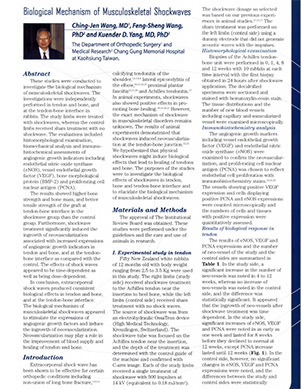Biological Mechanism of Musculoskeletal Shockwaves
Prokázané léčebné účinky rázové vlny

These studies were conducted to investigate the biological mechanism of musculoskeletal shockwaves.
Abstract:
These studies were conducted to investigate the biological mechanism of musculoskeletal shockwaves. The investigations were independently performed in tendon and bone, and at the tendon-bone interface in rabbits. The study limbs were treated with shockwaves, whereas the control limbs received sham treatment with no shockwave. The evaluations included histomorphological examination, biomechanical analysis and immunohistochemical assessments of angiogenic growth indicators including endothelial nitric oxide synthase (eNOS), vessel endothelial growth factor (VEGF), bone morphological protein (BMP-2) and proliferating cell nuclear antigen (PCNA).
The results showed higher bone strength and bone mass, and better tensile strength of the graft at tendon-bone interface in the shockwave group than the control group. Furthermore, shockwave treatment significantly induced the ingrowth of neovascularization associated with increased expressions of angiogenic growth indicators in tendon and bone, and at the tendon-bone interface as compared with the control. The effects of shock waves appeared to be time-dependent as well as being dose-dependent. In conclusion, extracorporeal shock wave produced consistent biological effects in tendon and bone, and at the tendon-bone interface. The biological mechanism of musculoskeletal shockwaves appeared to stimulate the expressions of angiogenic growth factors and induce the ingrowth of neovascularization. Neovascularization may play a role in the improvement of blood supply and healing of tendon and bone.
Více profesionálních studíí